Self-Tuning AI Strengthens Plant and Grid Reliability on Islands
Energy transition is progressively being adopted globally, pushing combined cycle gas turbines (CCGTs) to embrace flexible operation also on islands. CCGTs are, or will be, ramping loads up and down to accommodate intermittent renewable power inputs into the grid. These maneuvers compromise operational stability and jeopardize plant availability. Plant trips on small to mid-size islands not interconnected with larger mainland grids result in major, if not whole-island, outages. The ADEX Self-tuning AI (artificial intelligence) system boosts operational stability while optimizing plant performance and, in doing so, enables flexible operation without compromising reliability.
Island grids are often isolated power systems, not interconnected with mainland utilities, that rely on very few, or even a single, fossil-fueled power plants to provide grid frequency stability. These plants match generation with demand in real-time to fulfill this purpose. When failing to do so, the system’s quality of service is negatively affected and in extreme cases the whole grid can collapse. Consequently, the scarcity of power plants capable of providing stable grid frequency imperils the electric supply.
Despite this inherent grid fragility, current public policies further challenge island generators’ capacity to stabilize frequency. Energy transition goals impose flexible operation on fossil-fueled power plants, forcing them to vary loads to accommodate intermittent renewable power inputs into the grid and still meet variable demand. CCGTs are the most flexible and efficient generation technology usually chosen to carry out this task, and they do, but not without difficulties and setbacks. Frequently, the stringent maneuver requirements cause plant instability, resulting in trips, unscheduled outages, and posing a heavy toll on the facility’s equipment. Embracing a flexible, climate-friendly generation jeopardizes a traditional but still top-of-mind industry goal: reliability.
Islands’ electrical system operators are well aware of their circumstances. Within tight budgets, they try to ensure grid reliability, stability, and resilience with additional reserve capacity since no interconnection with mainland electric systems is available to provide support. Despite these efforts, plant trips and other incidents still cascade across the grid more rapidly and with worse outcomes on islands’ power systems.
With this burden, CCGT operations juggle across conflicting flexibility versus reliability objectives, with variable rates of success. On islands, repercussions derived from these competing objectives can hardly be overstressed.
At a power plant, a handful of well-known recurring issues can lead to partial or full unplanned outages. Arguably the most common trip cause is drum level instability. This article will focus on recurring drum level instability challenges and how the ADEX Drum Level Optimizer has solved these issues for its users.
The Control Problem
Proportional-integral-derivative (PID) controllers have been around for more than a century. They were massively adopted in many heavy industries during the 1950s because they could maintain industry variables around their setpoints for long periods with reduced human intervention. In doing so, they set the grounds for distributed control systems (DCSs) and automated industrial operations.
Although a breakthrough at the time, it is head-numbing how the legacy PID algorithm is still the primary tool currently used to control the vast majority of process variables in any industry, including drum levels in CCGTs. It is especially curious because PID controllers are well-known to cause oscillations around their setpoints in the variables they control, occasionally leading to resonance and operational instability, and requiring manual intervention from an experienced human operator. In fossil-fueled power plants, a unit can trip if the human operator fails to stabilize the critical process variables adequately.
From the early automation days, critiques of PID control and proponents of alternative solutions arose. A thorough examination of the chemical industry process control problems and the practical inadequacies of optimal and adaptive methodologies available at that time concluded that there was a gap between theory and practice in industrial process control. It added that “the gap is indeed present, but contrary to the views of many, it is the theoretician who has to close it.”
The study highlighted the required features of a solution that could be capable of breaching the gap. The solution would have to exploit interactions inherent in multivariable physical processes and be adaptive, but stable, even in the presence of unmodeled dynamics, unknown perturbations, and imprecise knowledge of parameters and measurements.
More than four decades later, in 2017, the president of the Institute of Electrical and Electronics Engineers (IEEE) Control System Society addressed the entire scientific control community in a message through the IEEE Control Systems magazine. In his message, he stressed that the gap between industrial control theory and practice has not been bridged and described this as the “AI control problem.” The president requested the community to renew its efforts and stated: “When we have a plant we wish to control, and we design a controller for it, there is always the risk that the closed-loop system will not behave as desired. More specifically, it might be unstable, resulting in all kinds of undesirable consequences, ranging from saturated amplifiers to catastrophic loss of life. … The real question is whether remedies can be found for the AI control problem.”
It is not that no progress or efforts have been made in the long period between these two articles, though. Several advanced process control (APC) systems have become available in the market based on various control methodologies, such as fuzzy logic, neural networks, or model predictive control (MPC). However, despite the overall operational enhancements, these APC systems still rely on PID controllers and, in all cases, depend on fixed-parameter-based algorithms to produce the outputs that are finally applied to the plant elements (valves, pumps, etc.).
The underlying problem of current fixed-parameter control systems is that the control parameters are tuned for certain operating conditions. When the process operating conditions change and the process dynamics diverge from the operating conditions during tuning, these parameters can become detuned, deteriorating control performance, and introducing process instability.
Overcoming the Control Problem: ADEX Self-tuning AI
A new Adaptive Predictive Expert (ADEX) control methodology was defined in a U.S. patent, and, later, the book “ADEX Optimized Adaptive Controllers and Systems: From Research to Industrial Practice,” presented the concepts of the ADEX control methodology, their practical implementation through the so-called ADEX systems, and the ADEX stability theory. In fact, this book describes the theory and industrial practice of a generic multivariable, adaptive, and stable control solution for industrial processes, able to achieve their optimal control performance, despite changes in the process dynamics and context of operation, together with noise and perturbations acting on them.
ADEX technology is based on self-tuning AI capable of identifying in real-time the process dynamics and their variations with time. This self-tuning AI allows ADEX controllers to accurately predict the process variables’ evolution and compute the control actions that make the predicted evolution equal to the desired evolution, optimizing process performance.
ADEX systems stabilize and optimize the overall performance of a process. They are defined by optimized process control strategies in which ADEX controllers are integrated.
ADEX systems have been applied to and currently operate numerous challenging applications in a wide variety of industrial areas with a reported success record in enhancing their process performance. These applications have proven experimentally that ADEX technology has bridged the gap between theory and practice that has existed for decades in process control, solving the so-called control problem of industrial processes.
Reinforcing Reliability Under Flexible Operating Conditions
Targeting ambitious flexibility objectives (such as higher ramping rates and lower minimum loads) affects a plant’s critical variables stability endangering reliability. ADEX Self-tuning AI reinforces operational stability mitigating reliability risks when leveling up flexible operation. For many plants struggling between reliability and operational flexibility objectives, ADEX Self-tuning AI enables meeting both.
CCGTs used for, and often specifically designed for, baseload operation can find stability and reliability challenges when pivoting operations toward flexible load-following. Figures 1 and 2 show the evolution of high-pressure (HP) and intermediate pressure (IP) drum levels in the same boiler when operating at baseload (without flexibility constraints) or load-following (flexible operation), respectively.
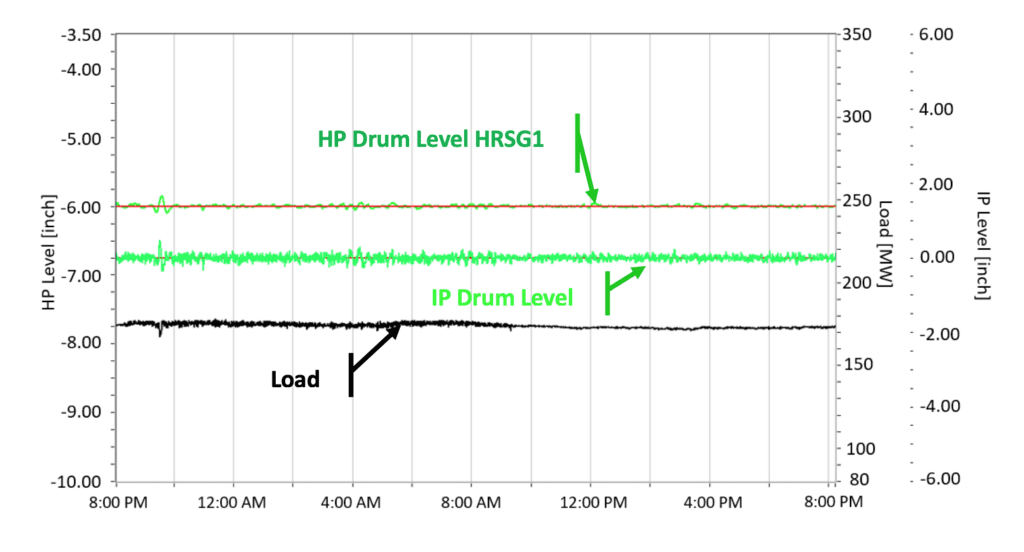
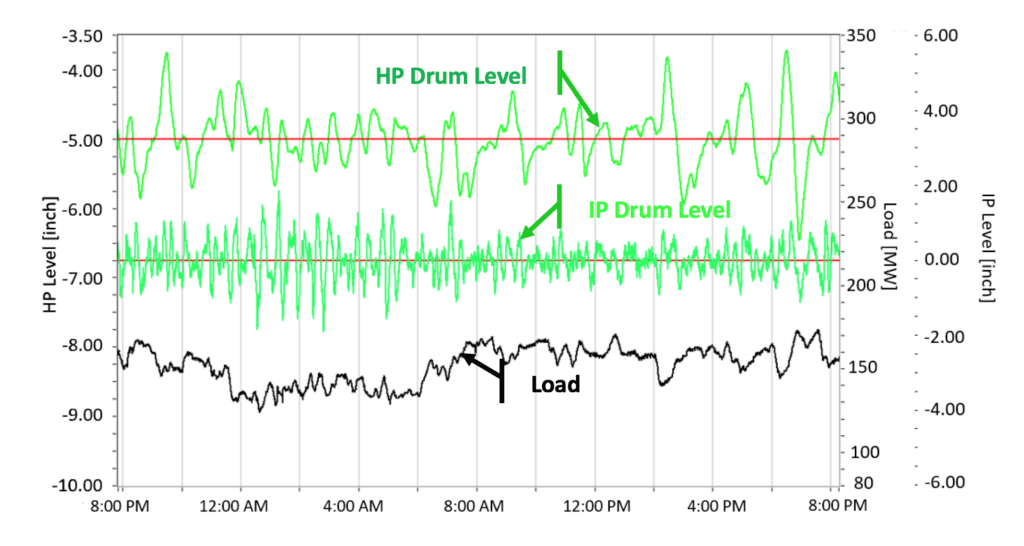
HP and IP drum levels are mission-critical variables that will trip the units when deviations from their setpoint surpass a threshold that depends on the drums’ constructive parameters. Reliability is at risk if this threshold is close enough to the level oscillations induced by load-following operation.
In plants that are challenged by embracing flexible operation, ADEX multivariable technology self-tunes in real-time to keep track of the critical variables’ changing dynamics when load-following, and reacts consequently to ensure optimal control performance and critical variable stability for every scenario. Figure 3 shows HP drum level stability tests, with and without an ADEX Drum Level Optimizer, carried out at a combined cycle power station in Italy when executing load ramps at 42 MW/minute. Figure 3 shows how ADEX safeguards drum level stability during challenging operations such as aggressive load-following.
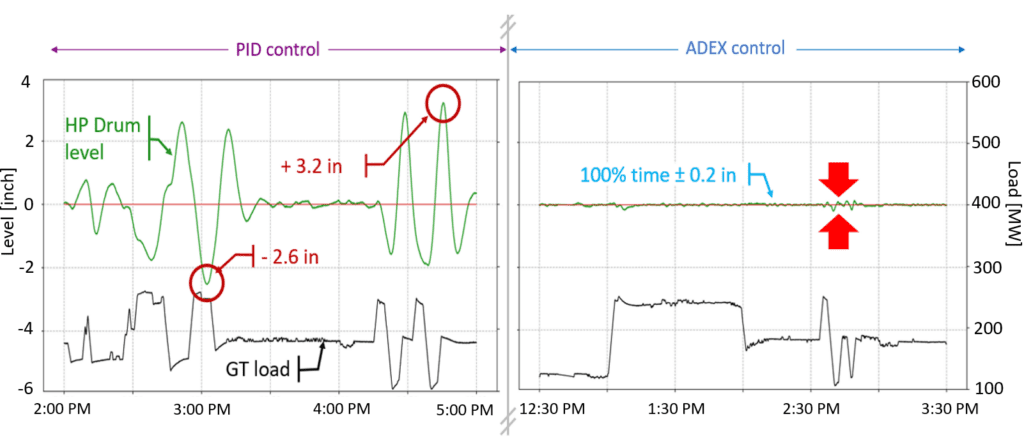
Case Study: Reinforcing Plant and Grid Reliability at EcoElectrica in Puerto Rico
Puerto Rico’s renewable resources include solar, wind, hydropower, and biomass. Under the Puerto Rico Energy Public Policy Act, the Puerto Rico Electric Power Authority (PREPA) must obtain 40% of its electricity supply from renewable resources by 2025, 60% by 2040, and 100% by 2050. In 2022, only 3% of PREPA’s electricity came from renewable energy. Solar distributed generation is rapidly growing in the residential and commercial sectors of the island. A small energy share comes from wind, hydroelectric, and landfill gas-fueled facilities. Despite the ambitious energy transition objectives, Puerto Rico is an isolated electrical system not connected to mainland utilities. Today, it relies on a single CCGT to ensure stable and robust grid frequency.
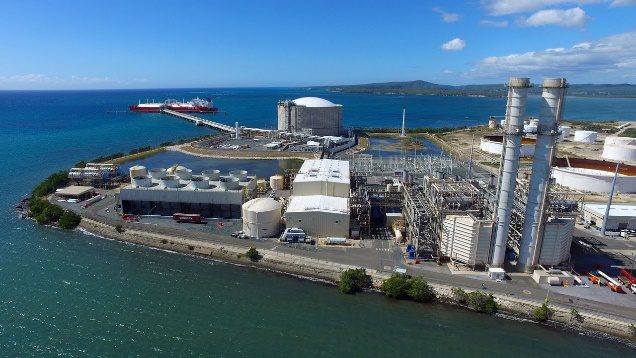
EcoEléctrica is a 2×1 CCGT in Peñuelas, Puerto Rico, co-owned by Global Power Generation, Engie, and Mitsui. The plant has a nameplate capacity of 540 MW generated by two 501FC Siemens/Westinghouse combustion gas turbines and a Toshiba steam turbine to produce approximately 20% of the island’s electricity. EcoEléctrica is Puerto Rico’s most reliable plant operating in automatic generation control (AGC) mode and, ultimately, responsible for maintaining the stability of the island’s grid frequency.
Despite EcoEléctrica’s fundamental role in Puerto Rico’s electric system, grid incidents frequently challenge its operations with repercussions on drums’ stability. Drum level stability has been an ongoing concern causing approximately three outages every two years. The expected steep increase in renewables poses a mighty challenge ahead for the plant’s operation.
EcoEléctrica addressed the issue by scouting the market for hi-tech solutions with proven success records of solving similar problems in the energy industry and opted to use ADEX technology. Figures 5 and 6 show trends of the HP and IP drum levels running with and without ADEX.
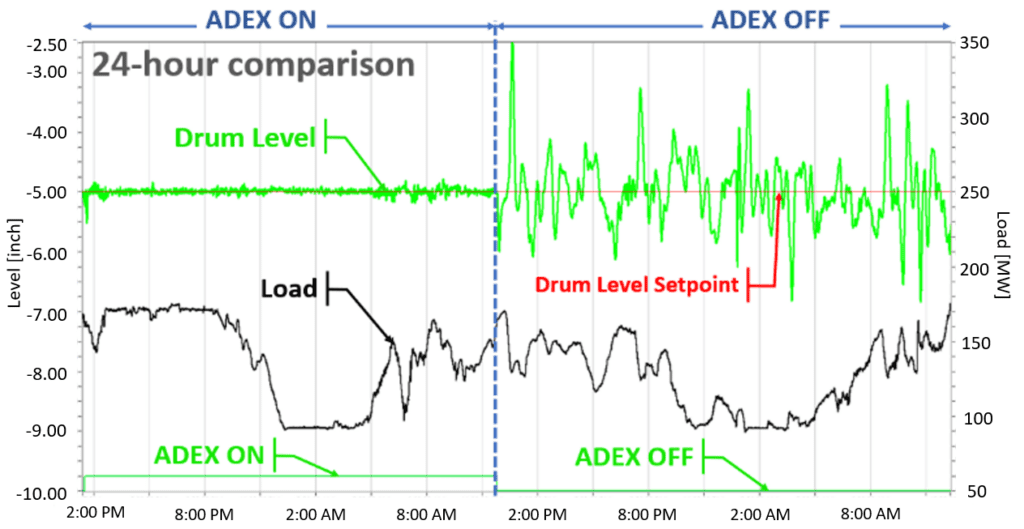
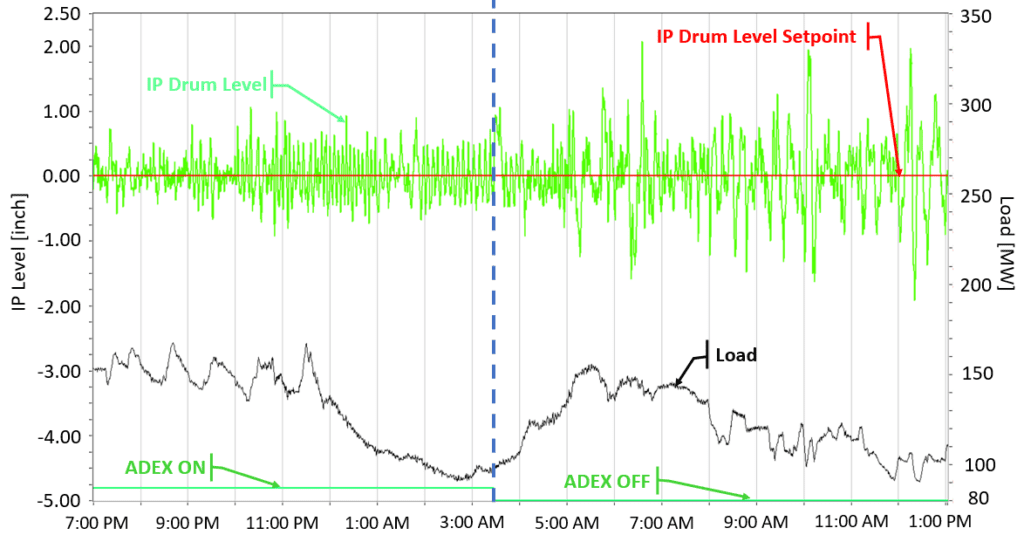
The ADEX Drum Level Optimizer reduced Ecoeléctrica’s level swings up to 90% in HP drums and up to 50% in IP drums. Figure 7 shows a seven-day trend with and without the ADEX Drum Level Optimizer.

Enhanced mission-critical variables stability, namely drum level stability, translates into reinforced reliability. However, even without the ADEX Drum Level Optimizer, reliability is not compromised daily, but rather when sporadic incidents, triggered externally or internally, come into play. In the following, ADEX’s Drum Level Optimizer performance is analyzed when one of these incidents took place.
Puerto Rico Grid Incident on November 14, 2022
On November 14, 2022, a fault on a 230-kV line shocked the Puerto Rico grid, taking three power units out of service. EcoEléctrica’s combustion turbines had to swing as fast as 300 MW/minute to restore grid frequency and avoid an outage. The impact at the very moment of the line failure on some of EcoElectrica’s critical variables is shown in Figure 8.
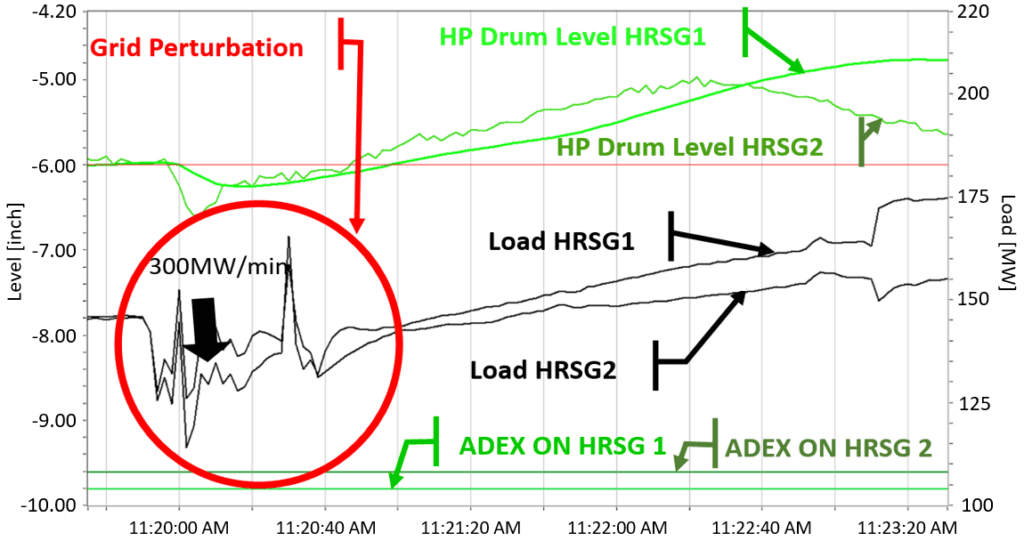
The aftermath of load swings, like the ones shown in the figure, is an extended period (hours) of plant instability where reliability is at stake. In this situation, concerns focus on the plant’s weak spot: drum levels. In similar past situations, drum level oscillations have caused the plant to trip, dragging the whole grid along.
However, this time ADEX controlled both heat recovery steam generator (HRSG) drum levels 100% of the time throughout the incident. ADEX kept drum levels within operational safety bands around their setpoints, acting on the boiler feed pumps and the feedwater valves that drive HP and IP levels, respectively.
Figure 9 zooms out of Figure 8, extending the timeline in the horizontal axis to show the repercussions of the load swings on the HP drum levels and the ADEX actions on the pumps to mitigate their oscillations. As shown in the figure, it took about four hours to return the unit to regular operation after the incident.
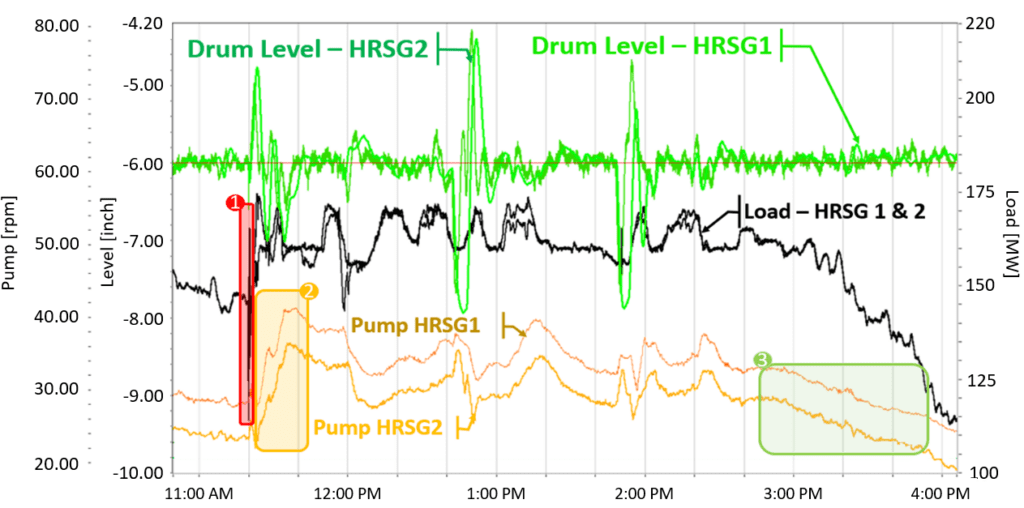
Labels 1, 2, and 3 have been added to the figure to clarify its explanation. Label 1 shows the load swings after the grid incident, previously shown in Figure 8, with a bigger zoom. These load swings not only deviate drum levels from their setpoints immediately, but also modify the drum level process’s dynamics. As discussed in previous sections, ADEX self-tunes in real-time its control parameters to keep track of the changing process’s dynamics and produce adequate responses for the changing operational scenario.
The area signaled by label 2 in the figure shows how ADEX’s control actions become significantly stronger after the load swings as the ADEX system adjusts to the new dynamics. Note that, at each of the replicas that took place after the incident, the ADEX system reacted similarly, significantly changing its control actions to address the new dynamics.
Finally, the area labeled as 3 shows how ADEX’s control actions have returned to their regular operation and are like those applied before the incident. Figure 10 shows the IP drum levels and the control actions applied by the ADEX system to the feedwater control valves.
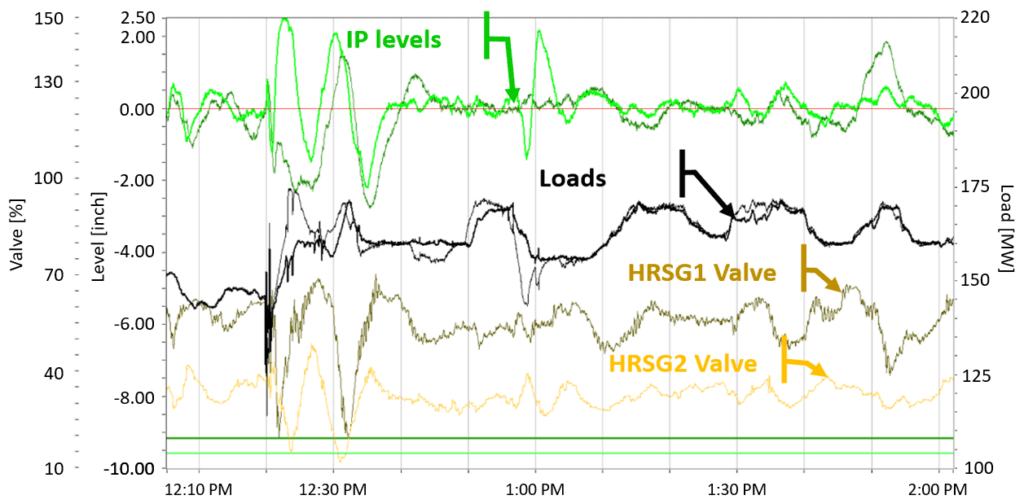
As in Figure 9, Figure 10 shows that the ADEX system applied stronger control actions right after the event to compensate for its effect. This kept IP levels under control throughout the event.
The “behavioral” changes of the ADEX system, shown in the last two figures, are due to the on-going self-tuning of ADEX controllers in response to dynamic changes induced by the grid incident. This self-tuning capacity kept drum levels under control throughout it.
According to Miguel Velez, an experienced operations supervisor, who was on watch during the incident, “A grid event like this one would have likely tripped the drums, then the plant, and jeopardized the stability of the whole grid.” The ADEX Drum Level Optimizer ensured EcoEléctrica’s levels stability, a considerable part of the island’s electric supply, and the whole grid’s frequency stability.
Conclusions
ADEX Self-tuning AI can boost CCGT operational stability, enabling flexible operation without undermining reliability. It is a cost-effective trip prevention software that yields substantial economic returns from keeping the plant running; satisfying dispatch orders through enhanced plant flexibility; and alleviating the toll that continuous trips pose on plant elements (thermal damage, abrupt operation, etc.). On fragile electrical systems, such as those of islands, its benefits are becoming crucial to ensure environmentally sustainable and reliable supply.
—Isaias Martin-Hoyo is the COO of ADEX in the U.S., Hector Martinez is the Head of Maintenance at EcoEléctrica, Benny Albarran is the Operations Manager at EcoEléctrica, Juan Glaria is a Senior Control Engineer at ADEX, and Emilio Anton is the Head of the Energy Department at ADEX.